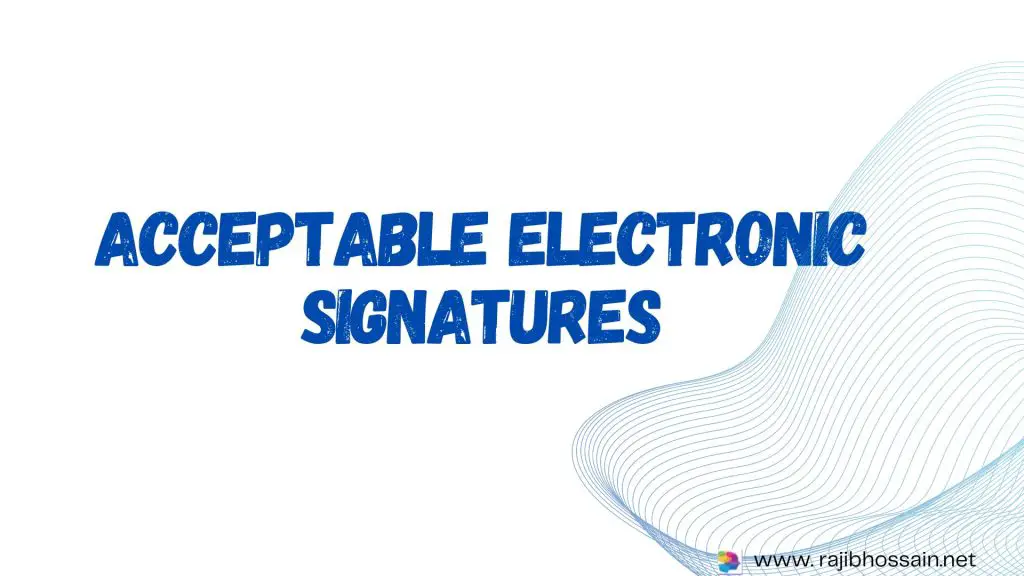
In today’s digital world, electronic signatures (e-signatures) have become a standard method for signing documents. They offer convenience, speed, and security compared to traditional paper-based signatures. However, understanding what constitutes an acceptable electronic signature is crucial for ensuring legality and compliance. This guide will explore the types of acceptable electronic signatures, their legal standing, and best practices for using them.
What is an Electronic Signature?
An electronic signature is a digital indication of a person’s intent to agree to or approve the contents of a document. E-signatures can take various forms, including:
- Typed Names: A simple typed name at the end of an email or document.
- Click-to-Sign: Clicking a button or checkbox to agree to terms or sign a document.
- Digital Signatures: A more secure form of electronic signature that uses encryption and digital certificates to verify the signer’s identity.
- Scanned Signatures: A handwritten signature scanned and inserted into a digital document.
Legal Standing of Electronic Signatures
1. United States (ESIGN Act and UETA)
In the United States, the Electronic Signatures in Global and National Commerce Act (ESIGN Act) and the Uniform Electronic Transactions Act (UETA) establish the legality of electronic signatures. These laws ensure that electronic signatures are legally equivalent to handwritten signatures if the following conditions are met:
- Intent to Sign: The signer must intend to sign the document.
- Consent: The signer must consent to use electronic signatures.
- Association: The electronic signature must be logically associated with the document.
- Record Retention: The document must be stored in a form that is accessible for future reference.
2. European Union (eIDAS Regulation)
In the European Union, the eIDAS (Electronic Identification, Authentication, and Trust Services) Regulation governs electronic signatures. It defines three levels of electronic signatures:
- Simple Electronic Signature: Basic electronic signatures that offer minimal security.
- Advanced Electronic Signature: Signatures that are uniquely linked to the signer and capable of identifying them.
- Qualified Electronic Signature: The highest level of security, equivalent to a handwritten signature, and backed by a qualified certificate issued by a trust service provider.
3. Other Jurisdictions
Many other countries have their laws and regulations governing electronic signatures. It’s important to understand the specific requirements in your jurisdiction to ensure compliance.
Types of Acceptable Electronic Signatures
1. Simple Electronic Signatures
These are the most basic form of e-signatures, including typed names or scanned images of handwritten signatures. They are suitable for low-risk transactions where the likelihood of dispute is minimal.
2. Advanced Electronic Signatures
These signatures provide a higher level of security and authentication. They are uniquely linked to the signer, capable of identifying the signer, and created using means that the signer can maintain under their sole control.
3. Qualified Electronic Signatures
Qualified electronic signatures are the most secure form of e-signatures, offering the highest level of trust and legal standing. They are created using a qualified signature creation device and based on a qualified certificate issued by a trust service provider.
Best Practices for Using Electronic Signatures
1. Choose the Right Type of Signature
Select the appropriate type of electronic signature based on the risk and legal requirements of the transaction. For high-risk or legally significant documents, consider using advanced or qualified electronic signatures.
2. Ensure Clear Intent and Consent
Make sure the signer’s intent to sign and their consent to use an electronic signature are clear. This can be done through checkboxes, declarations, or other methods that indicate agreement.
3. Use Secure Platforms
Utilize reputable and secure electronic signature platforms like DocuSign, Adobe Sign, or SignNow. These platforms offer robust security features, including encryption, authentication, and audit trails.
4. Maintain Records
Keep detailed records of signed documents, including the electronic signature, date, and time of signing. Ensure that the documents are stored securely and are accessible for future reference.
5. Stay Informed About Legal Requirements
Regularly review and stay informed about the legal requirements and regulations governing electronic signatures in your jurisdiction. This will help ensure ongoing compliance and avoid legal issues.
Conclusion
Electronic signatures are a valuable tool for modern business transactions, offering convenience, security, and legal validity. By understanding the different types of acceptable electronic signatures and following best practices, you can confidently use e-signatures for various documents and transactions. Always ensure compliance with legal standards and choose the right type of signature for your specific needs.
FAQ Section
1. Are electronic signatures legally binding?
Yes, electronic signatures are legally binding in many jurisdictions, including the United States and the European Union, as long as they meet specific requirements.
2. What are the different types of electronic signatures?
There are three main types: simple electronic signatures, advanced electronic signatures, and qualified electronic signatures. Each type offers different levels of security and legal standing.
3. Which electronic signature platform should I use?
Reputable platforms like DocuSign, Adobe Sign, and SignNow are popular choices. These platforms provide secure and legally compliant e-signature solutions.
4. Can I use a scanned signature as an electronic signature?
Yes, a scanned signature can be used as a simple electronic signature. However, it may not offer the same level of security and authenticity as advanced or qualified electronic signatures.
5. What should I consider when choosing an electronic signature type?
Consider the risk and legal requirements of the transaction. For high-risk or legally significant documents, use advanced or qualified electronic signatures for better security and legal standing.
By following these guidelines and understanding the various aspects of electronic signatures, you can effectively integrate e-signatures into your workflow, ensuring convenience, security, and compliance.
